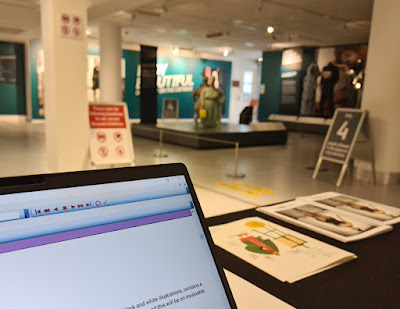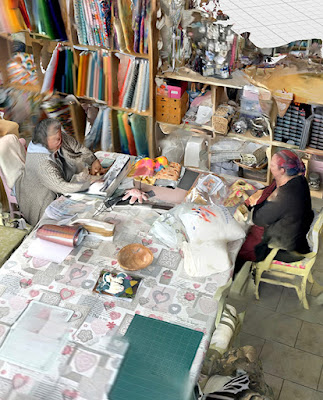In MoDiP we like to support and respond to various activities that happen across the AUB. This term our cultural partner TheGallery has been hosting a magnificent exhibition about fashion and diversity. Body Beautiful: Diversity on the Catwalk embraces inclusivity and body positivity and is open until 29 April 2022. The MoDiP team have been helping to invigilate the space and have enjoyed seeing the visitors exploring the themes and displays.
 |
Invigilating
the Body Beautiful: Diversity on the Catwalk exhibition to support our
AUB colleagues. Image credit: L. Dennis |
We have also put together our own exhibition in response to the theme of fashion and diversity. Body beautiful: plastics, looks at how this group of materials play an important role in empowering us to manage our own identity by enabling us to maintain and restore our bodies, enhance and transform our shape, and express our individuality.
Maintaining and restoring our bodies
Plastics
have contributed to the development of prosthetic devices due to their wide
range of mechanical, electrical, chemical and thermal qualities. They are inert, non-toxic and durable, with
the ability to perform in the precise environmental conditions found within the
human body. Different types of prosthetics are designed to achieve different
objectives. For example, some are
designed predominantly for appearance, to look as realistic as possible, whilst
others are purely functional, designed with usability as their main purpose.
Objects
in this case:
- Artificial eye, Cantor and Nissel, 2019. AIBDC : 008357
- Hip joint, Jean and Robert Judet, circa 1946-1954. AIBDC : 007807
- Acrylic denture, Unknown, circa 1950-1999. AIBDC : 008394
- Synthetic foot, Dorset Orthopaedic, 2019. AIBDC : 008380
 |
| Artificial eye and hip joint. Image credit: L. Dennis |
 |
Denture
and leg. Image credit: L. Dennis |
Enhancing and transforming our shape
In
all cultures the human body has, at some point, been enhanced or artificially
transformed to create a silhouette which conforms to traditions or fashions of
the day. Whether trying to achieve an
hourglass figure, a curve-less form, or a more toned, athletic build, plastics
materials can provide the required structure and support.
From
synthetic ‘whalebone’ to elastane shapewear and silicone enhancing pads, this
case exhibits a range of garments designed to target specific areas of the
body.
Objects
in this case:
- Synthetic whalebone, Unknown, 2019. AIBDC : 008365
- Zoned performance tank, Spanx, 2015. AIBDC : 007090
- Butt enhancing pants, Sodacoda, 2020. AIBDC : 008388
- Wonderbra, Louise Poirier, 1995. AIBDC : 000670
 |
| Spanx tank and Wonderbra. Image credit: L. Dennis |
Expressing ourselves
There
are many ways in which people can express individuality. We can do it through the clothes we wear and
the way we conduct ourselves. We can
also change our appearance temporarily, through wearing removable jewellery,
hairpieces and false nails, as well as more permanently, by adopting piercings
and 3-dimensional tattoos. Whilst body modification has been practised around
the world for thousands of years using a variety of natural materials, more
recently biocompatible plastics have become increasingly common, particularly
for those objects implanted under the skin.
Objects
in this case:
- Maasai armlet, Gelai Bomba village, 2010. AIBDC : 008451
- Amelia wig, Hairaisers, 2010. AIBDC : 006113
- Fabulously Flirty eyeimpact false eyelashes, Girls with Attitude, 2010. AIBDC : 006030
- Nailene Perfect Toes false toenails, Pacific World Corp, 2010. AIBDC : 006033
- 10mm acrylic ear plug, Unknown, circa 2010s. AIBDC : 008418.1
- 5mm acrylic ear plug, Unknown, circa 2010s. AIBDC : 008418.2
- Acrylic buffalo pincher, Unknown, circa 2010s. AIBDC : 008419
- 8mm hider plug, Unknown, circa 2010s. AIBDC : 008421
- Flexible ear tunnels, circa 2010s. AIBDC : 008422, 008455, 008456
- Subdermal horn implants, Steve Haworth, 2019. AIBDC : 008423.1 & 2
- Heart subdermal implant, Steve Haworth, 2019. AIBDC : 008424
- Half bead subdermal implant, Steve Haworth, 2019. AIBDC : 008425
- Anchor subdermal implant, Steve Haworth, 2019. AIBDC : 008426
We
look forward to the next opportunity we get to support our colleagues and be
inspired by the work they are doing.
Louise
Dennis, Curator of MoDiP





















